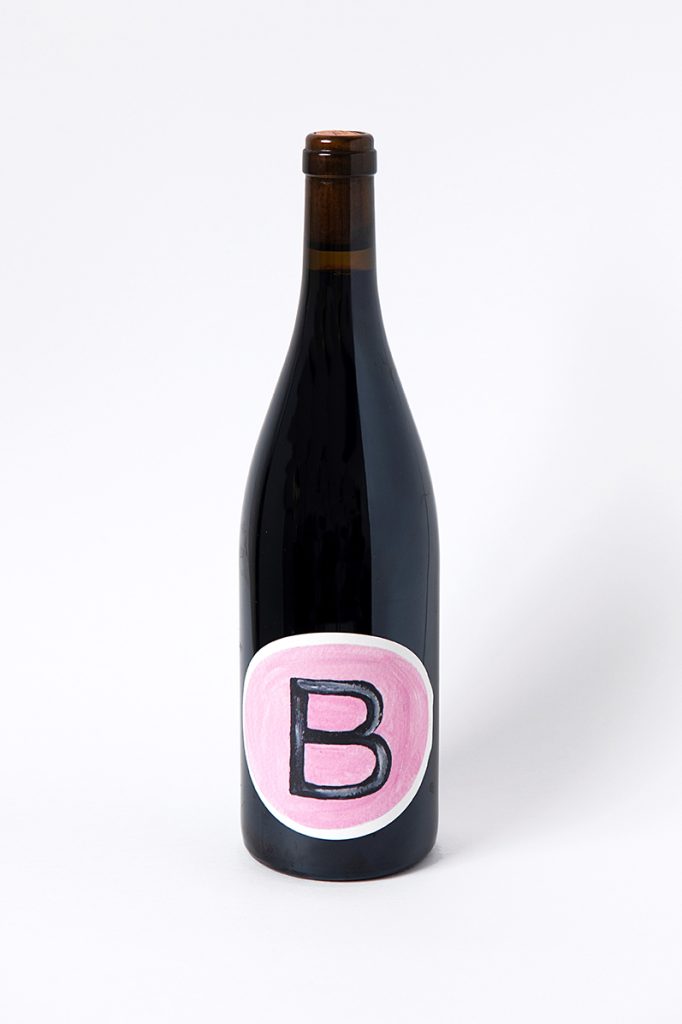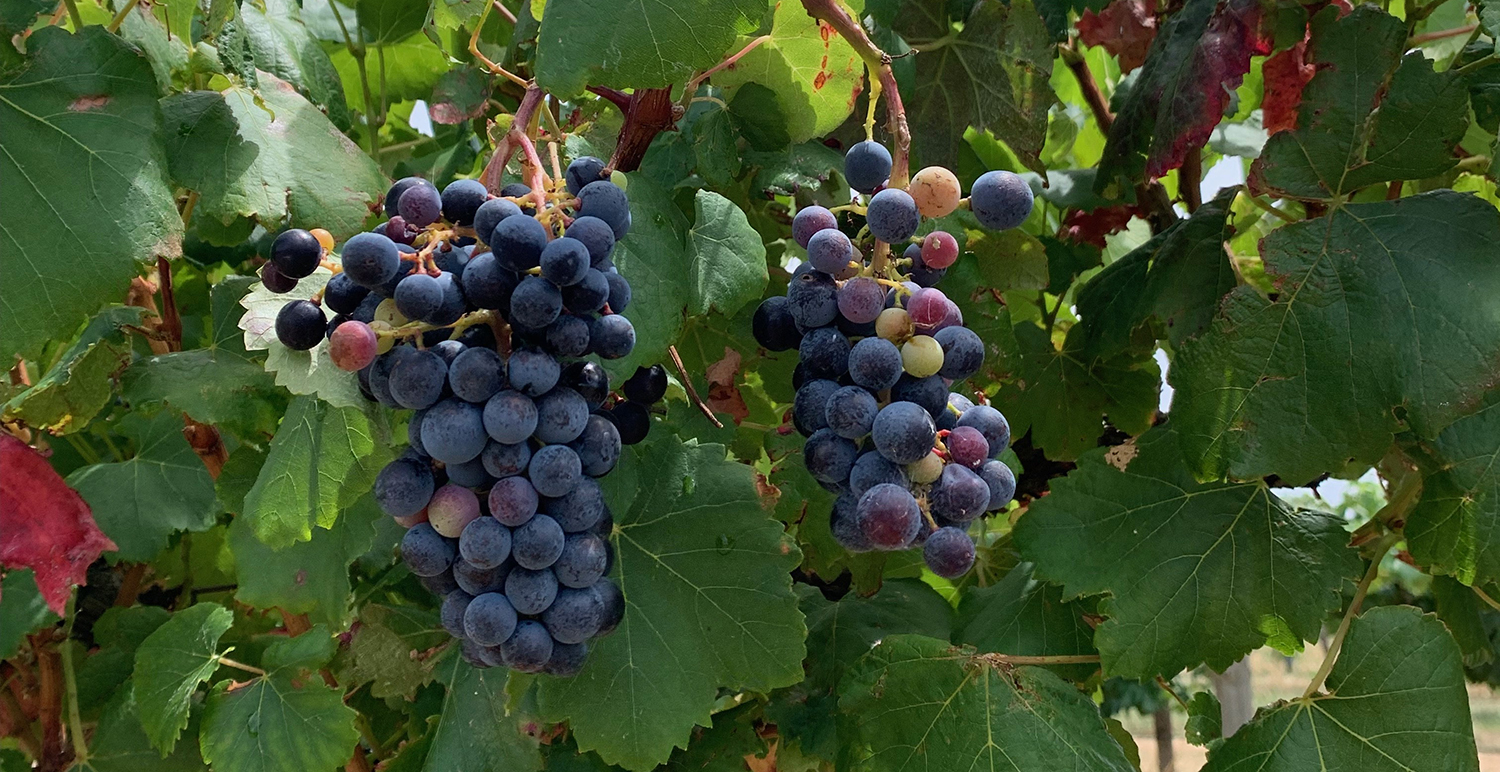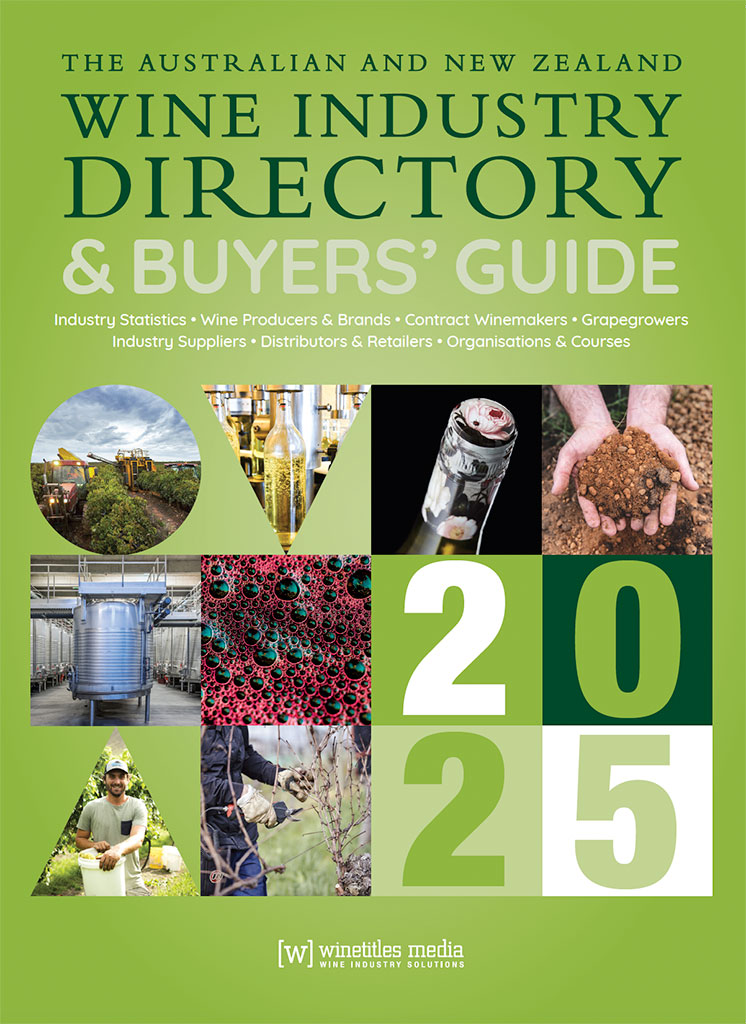Ripening Alicante Bouschet grapes in the Barossa Valley vineyard that provides the fruit for Bink Wines.
All the way with Alicante Bouschet
By Koen Janssens, Bink Wines, South Australia
The Background
Alicante Bouschet, or Alicante Henri Bouschet, has been widely grown since it was first cultivated by French viticulturist Henri Bouschet in 1866. It is a cross between Petit Bouschet and Grenache. The Petit Bouschet grape (itself a cross of the very old variety Teinturier du Cher and Aramon) was created by Henri Bouschet’s father Louis Bouschet. The result was a grape with deep colour and of higher quality than Teinturier du Cher. Several varieties of Alicante Bouschet were produced of varying quality.
The variety’s high yields and easy maintenance encouraged its popularity among French wine growers, especially following the phylloxera outbreak that ravaged the nation’s vineyards in the late 1800s. By the end of the 19th Century, there were Alicante Bouschet plantings in Bordeaux, Burgundy, Loire Valley and Alentejo in Portugal.
In the latter half of the 20th Century, Alicante Bouschet developed a reputation for producing uninspiring wines that lacked varietal distinction. Modern producers in Europe are working hard to change people’s perception of the variety and prove that, when grown properly, it is capable of making great wine that is fruity, fresh and balanced. However, its ability to ripen and produce large crops very early in the season can come at the expense of alcoholic strength.

Koen Janssens, from Bink Wines.
Alicante is a teinturier
Teinturier (meaning to dye or stain in French) varieties are red winegrapes that have dark skins and flesh, whereas most red winegrapes have dark skins and clear flesh. The colour of the flesh of Teinturier varieties is caused by anthocyanin pigments accumulating within the pulp of berries as opposed to being confined to the outer skin tissue. The juice squeezed from Teinturier varieties is red, whereas in most dark-skinned grape varieties the juice is clear.
Recognised by many today as a noble red variety (particularly in southern Iberia), Alicante Bouschet is known for its deep dark colour. Under specific conditions, the grape can produce high yields of up to 80 hectolitres per hectare. The grapevine is thought to be prone to grape diseases like anthracnose, downy mildew and, occasionally, bunch rots in rare instances where bunches are tight at harvest. Alicante Bouschet leaves turn a beautiful purple hue in late autumn.
The Vines
The block of Alicante Bouschet in Tanunda, in the Barossa Valley, that I source fruit from was grafted on Pedro Ximenez in the early 1990s. The vineyard still has an ‘old school’ planting system where vines are two metres apart and rows are four metres apart. The vineyard is just over two acres in size. Running north-south, the block is planted on a heavy sandy soil with loam deep underneath.
The block always delivers an amazing crop — generous bunches between 275g and 350g — and a good canopy. Producing multiple bunches per cane, I like to spur prune this block knowing that the vine will grow lots of canopy (it’s super vigorous) and fruit. It also gives me the opportunity every year to have a balanced and equal distribution of energy through each vine and good protection from the sun without creating an environment where humidity (read: powdery and downy) can thrive.

The wine(s)
As a lover of obscure varieties, the opportunity to make Alicante Bouschet in 2020 was a no-brainer. A winery had made a killer Alicante Bouschet that I was able to try a couple of months beforehand. This made my decision to make one even easier.
The Alicante Bouschet block (like all of my blocks) are hand harvested simply to minimise damage to the variety which loves to stain everything. 2020 was a difficult year with heatwaves during the latter stages of the growing season. I was unaware that Alicante Bouschets can be quite blunt sometimes (I had one ferment that was entirely destemmed fruit and it was pretty average). Having whole bunch ferments in the mix that year produced a wine that was as good as I thought I could make it. It was super bright with loads of red berries, tart fruits, purple florals and the smell of fresh cut hay. What was very notable from the beginning is that the fruit tasted very ripe on the vine but always came in with a low Baume and ended up low in alcohol.
The following year, 2021, was a god’s blessing — good rainfall in winter, no crazy weather conditions during the growing period, good flowering with again no extreme climate conditions, the stars aligned. I pulled a lot of fruit off the block that year so I was able to experiment quite a bit with Alicante Bouschet — some 100% whole bunch, some layered ferments, some shorter ferments, some extended ferments. The end result made me smile and realise what Alicante Bouschet is (and for me) always will be — a really good table wine, a conversation starter, a wine you can bring to a BBQ or to a roast, a wine that can sit after the white wine section in a degustation menu but can also star as the pièce de résistance; just very versatile.
Learning that Alicante Bouschet really loves old large format oak, I was able to put the wines in 500L puncheons to further develop the red berries and floral structure. Unfortunately, we got hit with hail just after flowering in the growing season of 2021-22. The block took a serious hit and I lost about 70% of the crop. The remaining fruit had some scars but nothing major (thank you canopy!). I made a 50/50 ferment with whole bunch clusters underneath and destemmed fruit on top. The wine is looking very promising this year — bright and lifted. I’m very excited because the general consensus is that 2022 is better than 2021 in the Barossa Valley. Time will tell.
Alicante Bouschet
By Peter Dry, Emeritus Fellow, The Australian Wine Research Institute
Background
Alicante Bouschet (ahlee-KAHN-tay boo-shay) is a red-fleshed variety that was the result of hybridisation from the mid-19th century in the south of France. The full name is ‘Alicante Henry Bouschet’ but it is usually known as ‘Alicante Bouschet’. Henri Bouschet crossed Grenache Noir and Petit Bouschet (Aramon Noir x Teinturier) — the resultant progeny named ‘Alicante Henry Bouschet’ and ‘Alicante Bouschet numbers 1, 2, 5, 6, 7, 12 and 13’ were subsequently released. Vineyards today are a mix of ‘Alicante Henry Bouschet’ and ‘Alicante Bouschet number 2’ (distinct but similar siblings). Synonyms include: Alicante, Dalmatinka (Croatia), Garnacha Tintorera (Spain), and Kambusa (Bosnia and Herzegovina). The global area in 2010 was 39,000ha (approximately doubled since 1990). The largest area is in Spain (52%), where more than half is found in central Castilla La Mancha. There is also a large area in Galicia. In France (13% of global area) it is mostly grown in the south, mainly in Herault where it is permitted to be used — unlike other red-fleshed hybrids with American Vitis parentage. It is also grown in Portugal (9%), Italy, Turkey, Hungary, Croatia, Cyprus and elsewhere. Outside of Europe, the largest areas are in Chile (11%), USA (California), Argentina, Uruguay, Algeria and Morocco. Alicante Bouschet was introduced to Australia in the 1960s but there are currently only 10 or so wine producers (Barossa Valley, Margaret River, Riverland, Eden Valley, Adelaide Plains, North-East Victoria and Hunter Valley).
Viticulture
Budburst is early and maturity early to mid-season. Vigour is moderate with semi-erect growth habit. Bunches are medium to large and well-filled to compact with medium berries with red pulp and dark red juice. Yield is moderate. It is pruned to spurs and reported to be heat tolerant. It is susceptible to downy mildew and bunch rot, but less so to oidium, and has low resistance to wind.
Wine
Alicante Bouschet is generally regarded as a low-quality variety in most regions of the world because its wine lacks character. It is mainly used to add colour in blends; however, its value as a colour enhancement variety is limited by the instability of red pigments in finished wine. One of the few places in the world where Alicante Bouschet wines are looked on more favourably is the hot Alentejo region in southern Portugal where it has been used for varietal wines.
For further information on this and other emerging varieties, contact Marcel Essling at the AWRI ([email protected] or 08 8313 6600) to arrange the presentation of the Alternative Varieties Research to Practice program in your region.


















